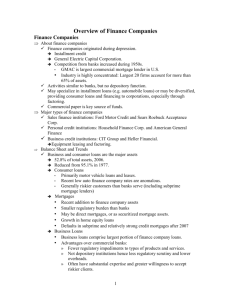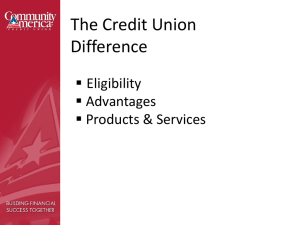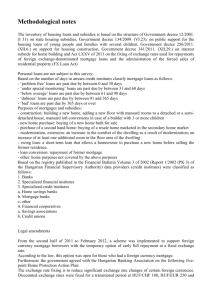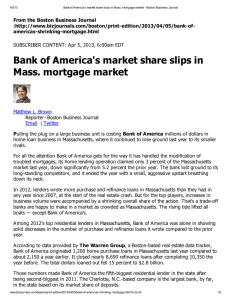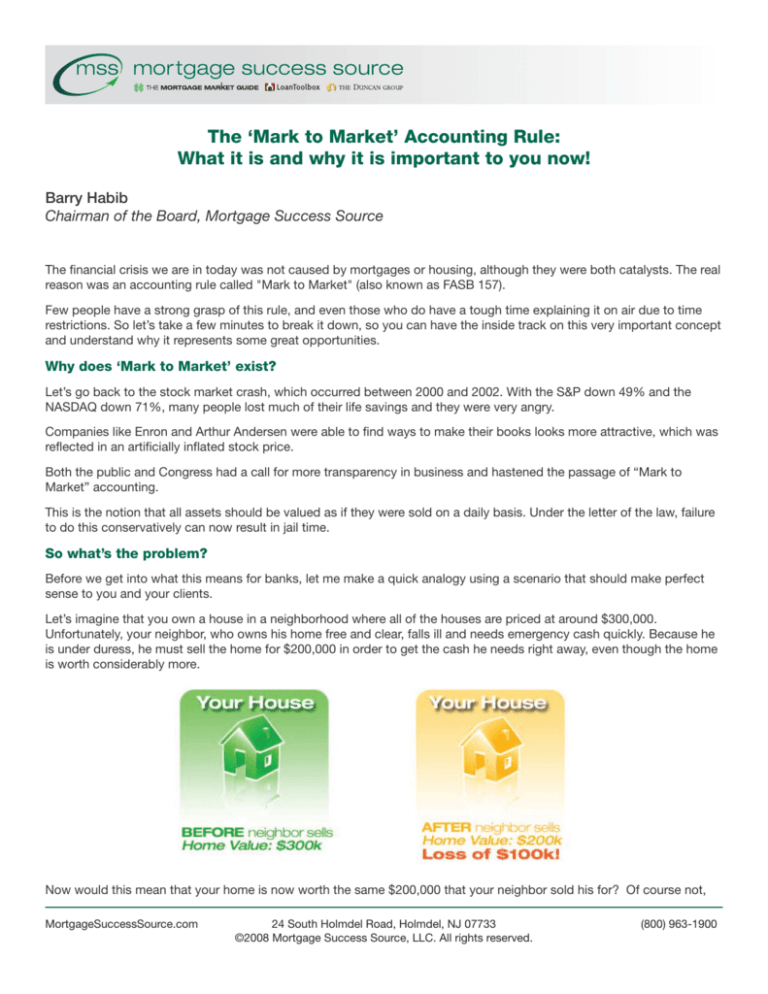
The ‘Mark to Market’ Accounting Rule:
What it is and why it is important to you now!
Barry Habib
Chairman of the Board, Mortgage Success Source
The financial crisis we are in today was not caused by mortgages or housing, although they were both catalysts. The real
reason was an accounting rule called "Mark to Market" (also known as FASB 157).
Few people have a strong grasp of this rule, and even those who do have a tough time explaining it on air due to time
restrictions. So let’s take a few minutes to break it down, so you can have the inside track on this very important concept
and understand why it represents some great opportunities.
Why does ‘Mark to Market’ exist?
Let’s go back to the stock market crash, which occurred between 2000 and 2002. With the S&P down 49% and the
NASDAQ down 71%, many people lost much of their life savings and they were very angry.
Companies like Enron and Arthur Andersen were able to find ways to make their books looks more attractive, which was
reflected in an artificially inflated stock price.
Both the public and Congress had a call for more transparency in business and hastened the passage of “Mark to
Market” accounting.
This is the notion that all assets should be valued as if they were sold on a daily basis. Under the letter of the law, failure
to do this conservatively can now result in jail time.
So what’s the problem?
Before we get into what this means for banks, let me make a quick analogy using a scenario that should make perfect
sense to you and your clients.
Let’s imagine that you own a house in a neighborhood where all of the houses are priced at around $300,000.
Unfortunately, your neighbor, who owns his home free and clear, falls ill and needs emergency cash quickly. Because he
is under duress, he must sell the home for $200,000 in order to get the cash he needs right away, even though the home
is worth considerably more.
Now would this mean that your home is now worth the same $200,000 that your neighbor sold his for? Of course not,
MortgageSuccessSource.com
24 South Holmdel Road, Holmdel, NJ 07733
©2008 Mortgage Success Source, LLC. All rights reserved.
(800) 963-1900
because you are not forced to sell under duress. It just means that your new neighbor got a great deal.
However, if you were a publicly traded company and had to abide by Mark to Market account rules, you and the rest of
your neighbors would now have to say, by law, that your home was worth only $200,000 – not the $300,000 you would
get for it if you actually sold. So what's the big deal? Read on.
So how does this principle apply to banks?
Let's say we decide to start a bank . . . call it XYZ Bank. We raise $2 Million to open our doors. Remember that our
capital account is $2 Million. Banks make money by taking in deposits and paying low rates of interest to those
depositors (maybe throw in a toaster too). We then take that money and make loans with it at higher rates. We keep the
difference.
So, we turn that money into $30 Million worth of loans. This puts our ratio of loans to capital (our Capital Ratio) at 15:1
($15 Million in Loans to $1 Million in Capital). This level is acceptable, as long as we can shoulder some losses and
recover.
Because we are very conservative here at XYZ Bank, the loans we make require a minimum down payment of 30%, a
credit score of 800 or better (that’s nearly an 850 which is perfect), proof of income and assets, a reserve of at least two
years of mortgage payments (normal is two months) and income requirements that only allow 10% of monthly income to
cover all expenses (normal is 40%).
We do this and our loans perform perfectly. We make lots of money. Nobody is paying late and our clients are sending us
holiday cards. They love us . . . it's a party. You and I are celebrating as we see our stock
price soar.
But real estate values decline and, even though all of our loans are paying perfectly, we
must re-assess the loan portfolio to account for the decline in real estate values, which
leaves us with less of an equity cushion. We had a minimum 30% down payment, which
means the loans were 70% of the value of our assets – until we account for the decline in
the market. Now, our position goes from 70% to 90%. That's riskier and, therefore, worth
less than when our loans had a 70% safety position.
Our accountants tell us that we must “Mark to Market” or risk jail. They say our value is
now reduced by $1 Million. Whoa!
We must take (or write down) this loss against our capital account. It is a paper loss - we
don't write a check, we have no late payers, no defaults, no bad business decisions. Still,
we must reflect this $1 Million paper loss in our Capital Account, which drops from a $2
Million to $1 Million in value.
Here’s where things get problematic.
At this level, with $30 Million in loans outstanding, we now have a capital ratio of 30:1. At
this level of leverage, alarms begin to sound.
Our ratios are out of the safe zone; we could go under with just a few losses, deposits are
in jeopardy. Hello FDIC examiner, we are on the watch list, the Securities and Exchange
Commission (SEC) is asking questions and our stock starts to tumble. The business
networks are showing coverage of our now troubled bank. We are in big trouble.
The problem, we are "over leveraged". The solution? We have to “de-lever” . . . and do so
quickly. But there are only two ways to do that, and one of them isn’t really an option.
The first way is to raise capital, but that’s not going to happen when our ratios are out of
MortgageSuccessSource.com
24 South Holmdel Road, Holmdel, NJ 07733
©2008 Mortgage Success Source, LLC. All rights reserved.
(800) 963-1900
whack and we are in serious trouble as well as on the FDIC watch list. It is unlikely that anyone will be willing to invest
cash in XYZ Bank.
The other option is that we can sell assets, like the outstanding loans, which are increasing our capital ratio. Like your
neighbor, who owned his home outright but needed cash for medical bills, we are now under duress. The paper we are
holding has a lot of value, but we have to sell it quickly and, because of that, cheaply. So, we offload the loans at a loss,
which exacerbates the problem because those losses further reduce our capital account.
Very quickly, like a flushing toilet, things start to spiral – we are going down.
The problem multiplies
The problem doesn’t stop there. The fire sale we just had on our loans makes things worse – even for the banks that
bought them up and thought they were getting a great deal.
Under Mark to Market, the loans we just sold must be included in the comparables that other financial institutions use to
value their assets. This is how the problem spread and got so bad so fast. Other good institutions, with good loans, have
to mark down. Just like us, they become over-leveraged. It’s a chain reaction, all triggered by a well intentioned, but
over-reaching accounting rule.
Financial institutions fold, sell, or freeze. Credit - the life blood of our economy - is cut off at the source. Because of a
lack of available credit, home sales and refinances crawl, auto sales drop and jobs are lost. Additionally, the economy
enters a recession.
During the last recession in 2001, the economy recovered relatively quickly thanks to $3 Trillion worth of home equity
withdrawals. But, more restrictive programs, a lack of available credit, and lower home values will make it difficult for us
to use home equity to help pull us out of a recession this time around.
Fixing the problem
The Federal Reserve has passed a rescue plan, which, over time, will provide some level of help. Some banks will get
money to infuse into their capital accounts. Others can sell some assets to the government in an effort to “de-lever”.
But, the big thing that is not talked about, not well understood, is the part of the rescue plan that traces this financial
crisis back to the source.
The US Congress has given the SEC its blessing to modify “Mark to Market” accounting. And by January 2, SEC
Chairman, Chris Cox has to get back to Congress with ideas, if any, on how to fix Mark to Market accounting.
It won't be eliminated, as we will not want to go back to the Enron days. But he is likely to adjust the Mark to Market
provisions.
MortgageSuccessSource.com
24 South Holmdel Road, Holmdel, NJ 07733
©2008 Mortgage Success Source, LLC. All rights reserved.
(800) 963-1900
Here’s one potential solution - even rental or commercial real estate properties can be valued two ways:
1. The comparable sales method, which determines the value based on what other assets have sold for, which
is the way Mark to Market work currently.
2. A cash flow method, which values the property based upon cash coming in.
If we see Mark to Market modified to use cash flow to value assets, without requiring a large percentage discounting
mechanism - wow! What a shot in the arm that would be. We’d likely see the stock market rally, with financial stocks
leading the uphill charge.
Consider that, in today’s market, fund managers are holding 27% of their assets in cash, compared with just 3% they
held in cash when the stock market peaked in October of 2007. That means there is a lot of money on the sidelines that
can push stock prices higher. Additionally, think about the redemptions from hedge funds that eventually need to be put
back to work. That’s another reason to be optimistic about stocks in the first quarter of 2009 – provided that Chairman
Cox modifies Mark to Market accounting in a meaningful way. And a good stock market helps individuals feel better
about purchasing homes. Additionally, stronger balance sheets for financial institutions will allow them to lend more
money.
The bottom line
With some potentially very good news around the corner, there might be reason for optimism as we head into 2009.
ABOUT MORTGAGE SUCCESS SOURCE
Mortgage Success Source (MSS) is the strategic alliance of Mortgage Market Guide, LoanToolbox and The
Duncan Group. Featuring the talents of industry leaders Barry Habib, Sue Woodard, Greg Frost, Todd
Duncan, and Jim McMahan, MSS provides money-making training and resources to more than 40,000 loan
originators nationwide. MSS is the one-stop-shop for loan originators looking to achieve higher levels of
success. All MSS products and technologies feature proven systems that are easy to implement and generate
increased loan volume.
MortgageSuccessSource.com
24 South Holmdel Road, Holmdel, NJ 07733
©2008 Mortgage Success Source, LLC. All rights reserved.
(800) 963-1900



